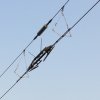Aictos
Established Member
- Joined
- 28 Apr 2009
- Messages
- 10,403
One for those more versed in the workings of both 3rd rail and OHL but if both routes are electrified on both systems, how are they setup?
I would have thought with 3rd rail you have gaps over the flat crossing but how would it work with OHL?
I know Newark flat crossing has OHL but that is only on one route which is the ECML not the Lincoln to Nottingham route so how would they have OHL for this location if both routes were electrified at OHL?
I would have thought with 3rd rail you have gaps over the flat crossing but how would it work with OHL?
I know Newark flat crossing has OHL but that is only on one route which is the ECML not the Lincoln to Nottingham route so how would they have OHL for this location if both routes were electrified at OHL?


